Microsoft ends support for Internet Explorer on June 16, 2022.
We recommend using one of the browsers listed below.
- Microsoft Edge(Latest version)
- Mozilla Firefox(Latest version)
- Google Chrome(Latest version)
- Apple Safari(Latest version)
Please contact your browser provider for download and installation instructions.
April 19, 2018
NTT successfully demonstrated a QoE-model based video streaming technology
~ Target QoE setting enables QoE enhancement and traffic reduction ~
Nippon Telegraph and Telephone Corporation (NTT) established a video quality control technology based on Quality of Experience (QoE) *1 in video streaming, succeeded in demonstration of the technology, where traffic was reduced while maintaining the target QoE. In our technology, based on the image quality and the playback stop time, the QoE of the watching video is evaluated by our original algorithm, a future communication quality is predicted considering the user's environment, and it optimally controls the bitrate in the midst of video streaming so as to achieve the preset QoE target. This technology for video streaming enables to maximize QoE, and to reduce the traffic while maintaining sufficient QoE.
We applied this technology to the experimental smartphone application for NTT Plala, Inc. (Plala) video streaming service, and conducted viewing experiments while changing the level of congestion such as inside the cafe or inside vehicle. It was confirmed by demonstration experiment that even in a crowded environment, users can smoothly watch videos with little stress, and service providers can deliver videos efficiently by streaming in sufficient video quality.
This technology is applicable to various video streaming services, CDN services, etc. It can be incorporated with minor modification to distribution server or smartphone application. In the future, based on the achievements of this demonstration experiment, we aim to further enhance the effect of technology in cooperation with each business operator, improve the user experience of video service, streamline network utilization and reduce costs.
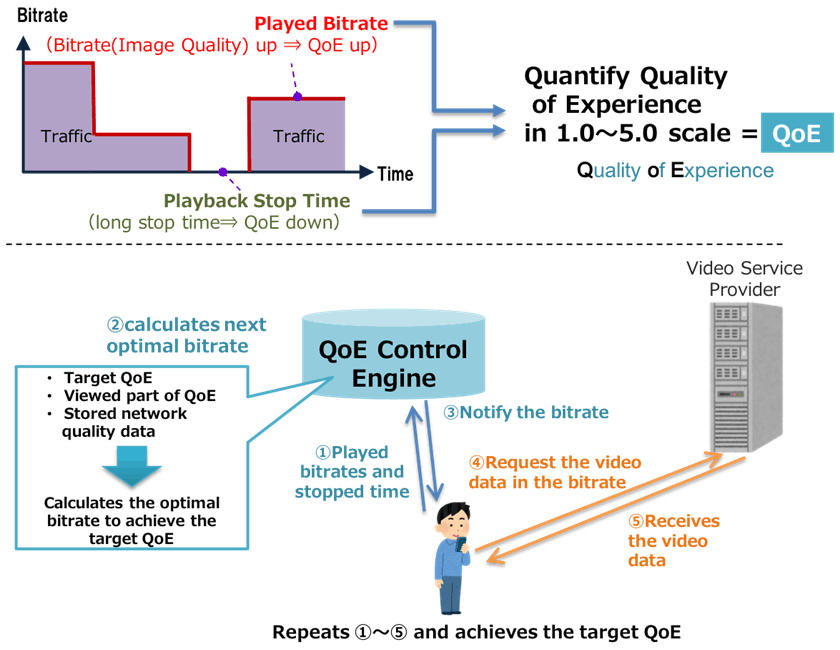
Background
Users' biggest problems in watching videos in mobile environments include poor viewing quality and increased packet charges. Currently, it is difficult for the service provider to properly control the viewing quality, some users feel stress because of insufficient viewing quality, and some users experience increased amount of traffic and cost due to excessive video quality.
In order to solve these two problems, NTT established a video quality control technology to control the bitrate that reduces the traffic amount as much as possible, while keeping the QoE above the preset target value.
In this technology, QoE can be maximized for each user viewing environment, and by setting the QoE target value to moderate, it is possible to minimize the generated traffic while maintaining sufficient QoE.
This experiment was applied to the application "Hikari-TV DOKODEMO" for smartphone of "Hikari-TV" video delivery service provided by Plala, and we conducted experiments to control the QoE of test users.
Research theme and its effect
For video viewing, the bitrate and playback stop time are the main determinants of QoE. QoE improves as the average bitrate in video viewing increases, and QoE decreases with longer playback stop time.
NTT has previously established an algorithm to estimate the QoE at viewing video from information such as the bitrate and playback stop time. Using this QoE estimation algorithm, we established a technology to control the video streaming so as to satisfy the target QoE, and conducted a demonstration experiment.
In normal video streaming, a video player requests video data from a video streaming server by specifying the video content and the bitrate (image quality), and it plays back the received data. In this experiment system, the video player inquires the QoE control engine before receiving the video data, acquires the bitrate information to be selected, and acquires the video data accordingly. At this time, the video player notifies the QoE control engine of the information such as the bitrates of the video data received so far, the playback stop time occurred during viewing, and the QoE control engine, using the preset QoE target value, calculate the optimum bitrate to be selected next. By repeating this flow, it is made possible to select the optimum bitrate, and to achieve video viewing at the preset QoE target value.
Effect of the technology and experimental results
In this experiment, we conducted experiments assuming the following two kinds of distribution purposes, and verified the effect. In the experiment, we repeatedly watched 300 seconds of video.
(1) When targeting the maximum QoE
When target QoE is set to 5.0 which is the maximum value of QoE, the technology controls so that QoE is maximized according to each user's viewing environment. With the conventional technology, the QoE has declined due to deterioration of image quality and playback stop, but with this technology, delivery with high QoE can be realized by improving image quality and reducing playback stop time.
In the experiment, we confirmed the following effects. As a result of analyzing the bitrate (image quality) during viewing and the playback stop time, that are the main factors of QoE, the average bitrate (image quality) has improved dramatically by 90% from 2.0 Mbps to 3.8 Mbps, The playback stop time was reduced by 38% from 12.4 seconds to 9.0 seconds, and the QoE value also increased by 6%.
In normal technologies, when increasing the bitrate, the data transfer can not be made in time so that the playback stop time will be extended. However, in our control technology, the communication quality in the user environment is appropriately predicted, so this result could be achieved by performing bitrate improvement while avoiding the occurrence of stop.
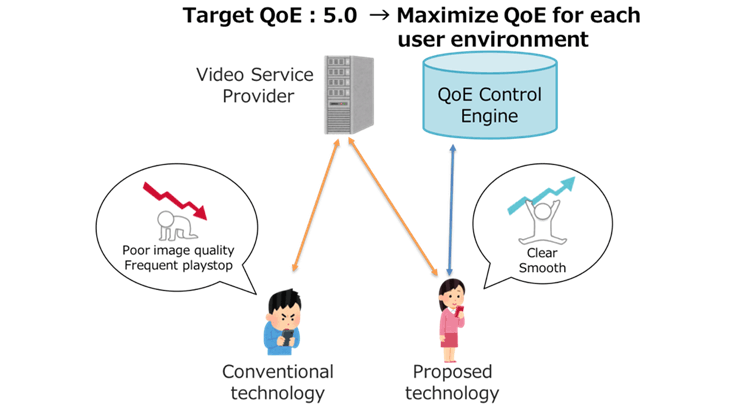
(2) When targeting a moderate QoE(e.g. 3.0-4.0)
When QoE target value is set to moderate level (3.0 to 4.0 etc.), it is possible to deliver in the necessary and sufficient QoE although it is not in the highest image quality. With this technology, a viewing in poor QoE in the conventional technique will be improved to a sufficient QoE level, and a viewing with the excessive image quality and QoE that involves large traffic amount will be degraded so that the necessary and sufficient QoE level is maintained, thereby lowering traffic volume.
In the experiment, while realizing the situation that the target quality, the average QoE here, is maintained, the average bit rate , that is, the traffic volume is reduced by 33% from 1.85 Mbps to 1.24 Mbps at the same time the average playback stop time is reduced from 20.5 seconds to 6.4 seconds by 68%.
In the proposed technology, by setting the QoE target value to a relatively low value, it was possible to reduce the number of views delivered with excessive quality, and that the communication quality for each user environment is properly predicted. Because of this, the effect of realizing video distribution control that reduces the amount of communication even when achieving the same QoE is realized.
In the proposed technology, by setting the QoE target value to a relatively low value, it was possible to reduce the number of views delivered with excessive quality, and that the communication quality for each user environment is properly predicted, so, it is considered, the optimal video distribution that reduces the communication volume could be realized.
Based on the above results, we confirmed the targeted effects of our streaming technology for each of the two settings. In actual service, setting and adjusting the QoE target value according to users, service specs, contents, etc. can improve the user experience of video streaming service.
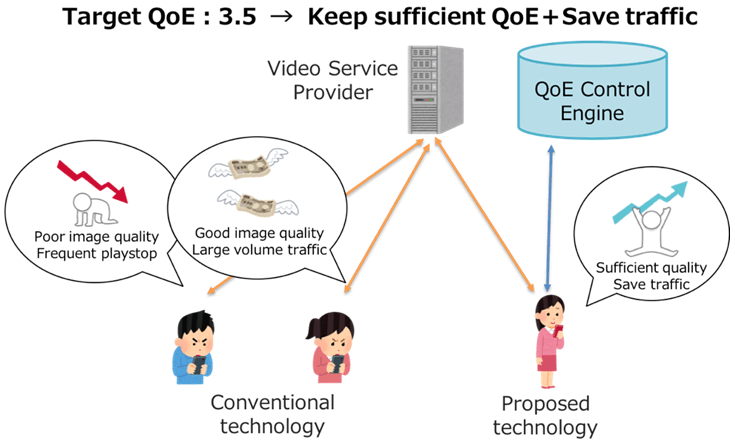
Future step
This experiment was conducted with only a part of the test users, but we will continue further examination for service development, such as expanding target users in the future. By deploying this technology to various services, we will improve the user viewing experience of video streaming service, improve efficiency of network use by service providers.
Glossary
- QoE
It stands for Quality of Experience, which refers to the quality of experience that the user feels when using the service. QoE is an index of human feeling quality expressed in the range of 1.0 to 5.0, and it is calculated using the average bitrate during watching videos, the stop time of playback, and so on.
Ref1: The details of QoE control engine
In the QoE control engine, viewed part of QoE is calculated from the information such as the selected and viewed bitrate received from the user's video player and the playback stop time. Also, based on past communication quality information accumulated in the quality database, we estimate the future communication quality (throughput) in the user's communication environment. We perform optimization calculation using these values and calculate a bitrate sequence to achieve preset target QoE in the future ahead of a certain time.
Fig. 4 The inside process of QoE control engineRef2: Experiment Result
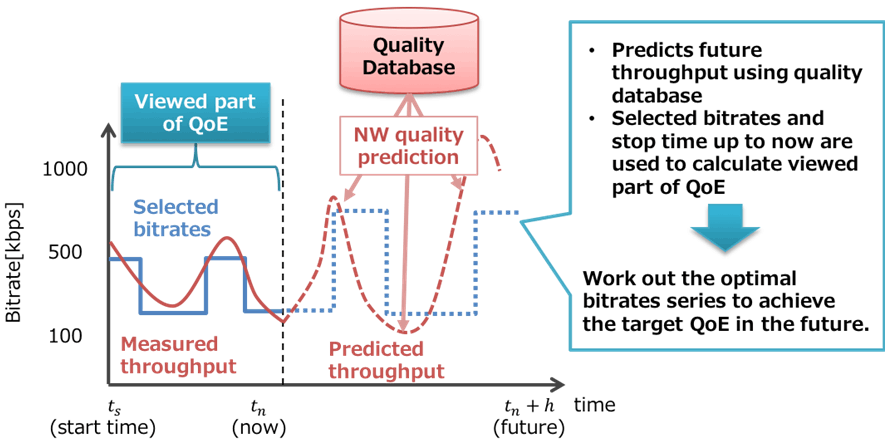
(1)The result for targeting maximum QoE(5.0)
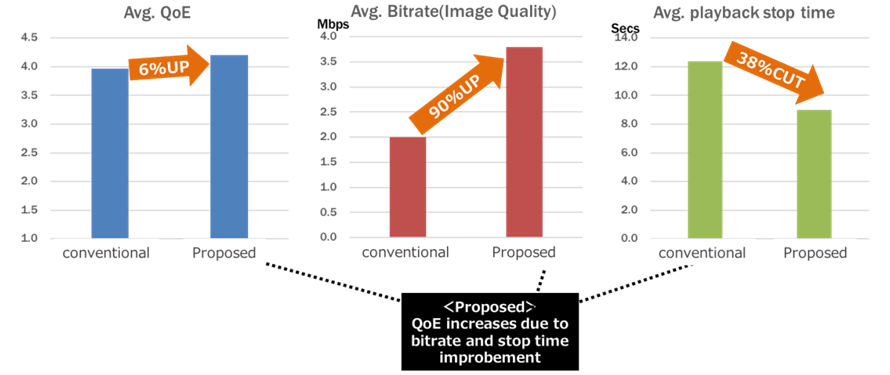
(2)The result for targeting moderate QoE(3.5)
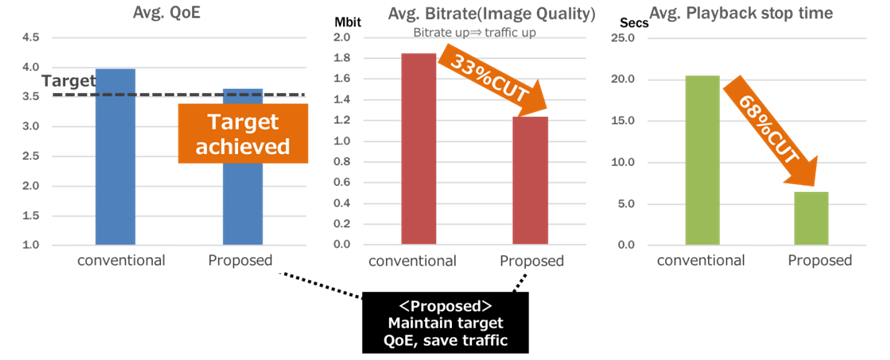
Contact information
NTT Information Network Laboratory Group
Planning Department, Public Relations Section
Email: inlg-pr-pb-ml@hco.ntt.co.jp
Information is current as of the date of issue of the individual press release.
Please be advised that information may be outdated after that point.
NTT STORY
WEB media that thinks about the future with NTT











